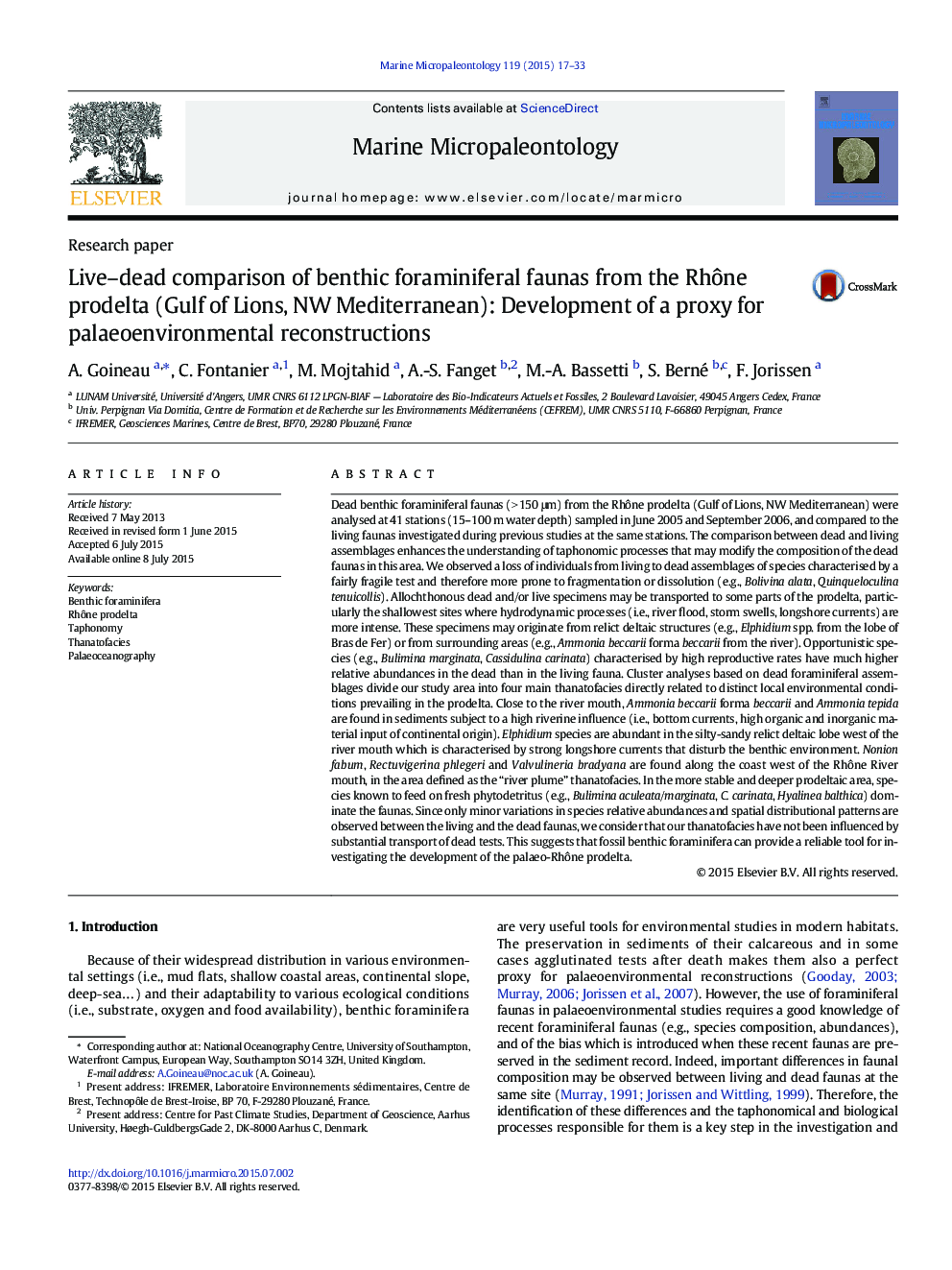| کد مقاله | کد نشریه | سال انتشار | مقاله انگلیسی | نسخه تمام متن |
|---|---|---|---|---|
| 4748809 | 1642166 | 2015 | 17 صفحه PDF | دانلود رایگان |

• Dead faunas were compared with living ones at 41 stations in the Rhône prodelta.
• Minor compositional and spatial variations exist between living and dead faunas.
• Four thanatofacies reflect distinct local environmental conditions in the prodelta.
• Fossil benthic foraminifera are reliable tools to study the palaeo-Rhône prodelta.
Dead benthic foraminiferal faunas (> 150 μm) from the Rhône prodelta (Gulf of Lions, NW Mediterranean) were analysed at 41 stations (15–100 m water depth) sampled in June 2005 and September 2006, and compared to the living faunas investigated during previous studies at the same stations. The comparison between dead and living assemblages enhances the understanding of taphonomic processes that may modify the composition of the dead faunas in this area. We observed a loss of individuals from living to dead assemblages of species characterised by a fairly fragile test and therefore more prone to fragmentation or dissolution (e.g., Bolivina alata, Quinqueloculina tenuicollis). Allochthonous dead and/or live specimens may be transported to some parts of the prodelta, particularly the shallowest sites where hydrodynamic processes (i.e., river flood, storm swells, longshore currents) are more intense. These specimens may originate from relict deltaic structures (e.g., Elphidium spp. from the lobe of Bras de Fer) or from surrounding areas (e.g., Ammonia beccarii forma beccarii from the river). Opportunistic species (e.g., Bulimina marginata, Cassidulina carinata) characterised by high reproductive rates have much higher relative abundances in the dead than in the living fauna. Cluster analyses based on dead foraminiferal assemblages divide our study area into four main thanatofacies directly related to distinct local environmental conditions prevailing in the prodelta. Close to the river mouth, Ammonia beccarii forma beccarii and Ammonia tepida are found in sediments subject to a high riverine influence (i.e., bottom currents, high organic and inorganic material input of continental origin). Elphidium species are abundant in the silty-sandy relict deltaic lobe west of the river mouth which is characterised by strong longshore currents that disturb the benthic environment. Nonion fabum, Rectuvigerina phlegeri and Valvulineria bradyana are found along the coast west of the Rhône River mouth, in the area defined as the “river plume” thanatofacies. In the more stable and deeper prodeltaic area, species known to feed on fresh phytodetritus (e.g., Bulimina aculeata/marginata, C. carinata, Hyalinea balthica) dominate the faunas. Since only minor variations in species relative abundances and spatial distributional patterns are observed between the living and the dead faunas, we consider that our thanatofacies have not been influenced by substantial transport of dead tests. This suggests that fossil benthic foraminifera can provide a reliable tool for investigating the development of the palaeo-Rhône prodelta.
Journal: Marine Micropaleontology - Volume 119, September 2015, Pages 17–33